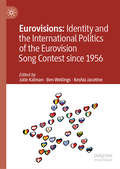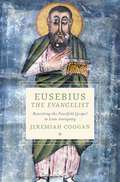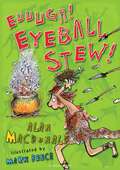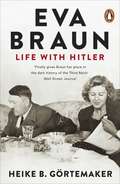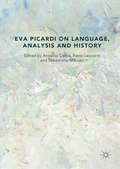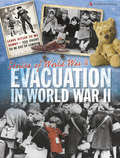- Table View
- List View
The Eurosceptical Reader
by M. HolmesThe Eurosceptical Reader is the authoritative guide to the compelling arguments against European integration. The book sets out to dispel the myth which has grown up over the past thirty years that Britain's Eurosceptics are backward-looking, nationalistic, even xenophobic 'Little Englanders'. In reality, as this collection of articles and speeches illustrates, the Eurosceptical case has been anything other than introverted and obsessed with the past. Eurosceptics have always looked to the wider world beyond Europe not to a nostalgic British isolation. Whether from within the two main parties or from academia and journalism, the Eurosceptical case has become both intellectually powerful and politically persuasive. The all-star cast provides contemporary analysis to supplement classic contributions from Hugh Gaitskell, Margaret Thatcher, Enoch Powell, Tony Benn and others.
Eurovision!: A History of Modern Europe Through the World's Greatest Song Contest
by Chris WestAn entertaining look at the changing face of the Eurovision Song Contest and the political and cultural influences behind its kitsch and glitzy façade.Do you think the world of the Eurovision Song Contest, with its crazy props, even crazier dancers, and crazier still songs has nothing to do with serious European politics? Think again. The contest has been a mirror for cultural, social, and political developments in Europe ever since its inauguration, when an audience in dinner jackets and ball gowns politely applauded each song. It has been a voice of rebellion across the Iron Curtain, an inspiration for new European nations in the 1990s and 2000s, the voice of liberation for both sexual and regional minorities. It even once triggered a national revolution.Eurovision! charts both the history of Europe and the history of the Eurovision Song Contest over the last six decades, and shows how seamlessly they interlink — and what an amazing journey it has been.
Eurovisions: Identity and the International Politics of the Eurovision Song Contest since 1956
by Julie Kalman Ben Wellings Keshia JacotineThis book uses the Eurovision Song Contest (ESC), as an analytical entry point to understand and illuminate post-War Europe and the drive to create an identity that can legitimise the European project in its broadest sense. The ESC presents an idealised vision of Europe, and this has long existed in a strained relationship with reality. While the trajectory of post-war European integration is a high-profile topic, we believe that the ESC offers a unique and innovative way to think about the role of culture in the history of post-War European integration and tensions between the ideal and reality of European unity. Through the series of case studies that make up the chapters in this book, analysis brings these interlinked tensions to light, exploring the roles of culture and identity, alongside and a productive conversation with the political and economic projects of post-war European integration.
Eurydice and the Birth of Macedonian Power (WOMEN IN ANTIQUITY)
by Elizabeth Donnelly CarneyEurydice (c.410-340s BCE) played a significant part in the public life of ancient Macedonia, the first royal Macedonian woman known to have done so, though hardly the last. She was the wife of Amyntas III, the mother of Philip II (and two other short-lived kings of Macedonia), and grandmother of Alexander the Great. Her career marks a turning point in the role of royal women in Macedonian monarchy, one that coincides with the emergence of Macedonia as a great power in the Hellenic world. This study examines the nature of her public role as well as the factors that contributed to its expansion and to the expanding power of Macedonia. Some ancient sources picture Eurydice as a murderous adulteress willing to attempt the elimination of her husband and her three sons for the sake of her lover, whereas others portray her as a doting and heroic mother whose actions led to the preservation of the throne for her sons. While the latter view is likely closer to historical reality, both the "good" and "bad" Eurydice traditions portray her as the leader of a faction, an active figure at court and in international affairs. Eurydice's activity, sinister or not, directly related to the fact that, at the time of her husband's death, the eldest of her three sons was barely old enough to rule and enemies, foreign and domestic, threatened. Two of Eurydice's sons were assassinated and the third died in battle. Eurydice functioned not only a succession advocate for her sons but she also played a part in the construction of the public image of the dynasty, both because of her own actions and because of the ways in which her son Philip II chose to depict and commemorate her. Drawing on recent archaeological discoveries and all surviving literary evidence, this portrait illuminates the life of a remarkable queen at the birth of a celebrated epoch.
EURYDICE & BIRTH OF MACEDON POWER WIA C (WOMEN IN ANTIQUITY)
by Elizabeth Donnelly CarneyEurydice (c.410-340s BCE) played a significant part in the public life of ancient Macedonia, the first royal Macedonian woman known to have done so, though hardly the last. She was the wife of Amyntas III, the mother of Philip II (and two other short-lived kings of Macedonia), and grandmother of Alexander the Great. Her career marks a turning point in the role of royal women in Macedonian monarchy, one that coincides with the emergence of Macedonia as a great power in the Hellenic world. This study examines the nature of her public role as well as the factors that contributed to its expansion and to the expanding power of Macedonia. Some ancient sources picture Eurydice as a murderous adulteress willing to attempt the elimination of her husband and her three sons for the sake of her lover, whereas others portray her as a doting and heroic mother whose actions led to the preservation of the throne for her sons. While the latter view is likely closer to historical reality, both the "good" and "bad" Eurydice traditions portray her as the leader of a faction, an active figure at court and in international affairs. Eurydice's activity, sinister or not, directly related to the fact that, at the time of her husband's death, the eldest of her three sons was barely old enough to rule and enemies, foreign and domestic, threatened. Two of Eurydice's sons were assassinated and the third died in battle. Eurydice functioned not only a succession advocate for her sons but she also played a part in the construction of the public image of the dynasty, both because of her own actions and because of the ways in which her son Philip II chose to depict and commemorate her. Drawing on recent archaeological discoveries and all surviving literary evidence, this portrait illuminates the life of a remarkable queen at the birth of a celebrated epoch.
Eurythmy and Rudolf Steiner: Origins and Development 1912-39
by Tatiana KisseleffIn the autumn of 1912, Rudolf Steiner presented the first eurythmy performance. It marked the revival, in modern form, of the sacred art of dance, which had been used in the ancient Mysteries to express the movements of the stars and the planets. In the years that followed, Steiner and his wife, Marie von Sivers, developed eurythmy further, broadening it beyond the artistic to encompass healing and educational elements as well.One of the pioneers of this new form of movement was the Russian anthroposophist Tatiana Kisseleff, who became a student of Steiner's and later a celebrated eurythmy teache.In this remarkable book, available for the first time in English, Kisseleff describes the spiritual foundations of eurythmy as they were explored in Steiner's lectures and recounts the instruction she received from him. This is both an eyewitness account of the origins of eurythmy and a record of a deeply personal journey of one person's efforts to master it. The book is illustrated throughout with photographs, drawings, facsimile reproductions from notebooks and posters advertising early eurythmy performances, alongside accounts of performances of various pieces including Shakespeare's The Tempest, Goethe's Faust, and Rudolf Steiner's own Mystery Dramas. This is a fascinating account for eurythmists and anyone who wants to delve more deeply into eurythmy's history and development.
Eusebius (Understanding Classics)
by Aaron P. JohnsonEusebius of Caesarea (263-339 CE) is one of the most important intellectuals whose writings survive from late antiquity. His texts made lasting and wide-ranging contributions, from history-writing and apologetics to biblical commentary and Christian oratory. He was a master of many of the literary and scholarly traditions of the Greek heritage. Yet he left none of these traditions unaltered as he made brilliant and original experiments in the many genres he explored. Aaron P Johnson offers a lively introduction to Eusebius' chief oeuvre while also discussing recent scholarship on this foundational early Christian writer. Placing Eusebius in the context of his age the author provides a full account his life, including the period when Eusebius controversially sought to assist the heretic Arius. He then discusses the major writings: apologetic treatises; the pedagogical and exegetical works; the historical texts; the anti-Marcellan theological discourses; and expositions directly connected to the Emperor Constantine.
Eusebius the Evangelist: Rewriting the Fourfold Gospel in Late Antiquity (Cultures of Reading in the Ancient Mediterranean)
by Jeremiah CooganEusebius the Evangelist analyzes Eusebius of Caesarea's fourth-century reconfiguration of the Gospels as a window into broader questions of technology and textuality in the ancient Mediterranean. The four Gospels of the New Testament (Matthew, Mark, Luke, and John) share language, narratives, and ideas, yet they also differ in structure and detail. The sophisticated system through which Eusebius organized this intricate web of textual relationships is known as the Eusebian apparatus. Eusebius' editorial interventioninvolving tables, sectioning, and tables of contentsparticipates in a broader late ancient transformation in reading and knowledge. To illuminate Eusebius' innovative use of textual technologies, the study juxtaposes diverse ancient disciplinesincluding chronography, astronomy, geography, medicine, philosophy, and textual criticismwith a wide range of early Christian sources, attending to neglected evidence from material texts and technical literature. These varied phenomena reveal how Eusebius' fourfold Gospel worked in the hands of readers. Eusebius' creative juxtapositions of Gospel material had an enduring impact on Gospel reading. Not only did Eusebius continue earlier trajectories of Gospel writing, but his apparatus continued to generate new possibilities in the hands of readers. For more than a millennium, in over a dozen languages and in thousands of manuscripts, Eusebius' invention transformed readers' encounters with Gospel text on the page. By employing emerging textual technologies, Eusebius created new possibilities of reading, thereby rewriting the fourfold Gospel in a significant and durable way.
Eusebius the Evangelist: Rewriting the Fourfold Gospel in Late Antiquity (Cultures of Reading in the Ancient Mediterranean)
by Jeremiah CooganEusebius the Evangelist analyzes Eusebius of Caesarea's fourth-century reconfiguration of the Gospels as a window into broader questions of technology and textuality in the ancient Mediterranean. The four Gospels of the New Testament (Matthew, Mark, Luke, and John) share language, narratives, and ideas, yet they also differ in structure and detail. The sophisticated system through which Eusebius organized this intricate web of textual relationships is known as the Eusebian apparatus. Eusebius' editorial interventioninvolving tables, sectioning, and tables of contentsparticipates in a broader late ancient transformation in reading and knowledge. To illuminate Eusebius' innovative use of textual technologies, the study juxtaposes diverse ancient disciplinesincluding chronography, astronomy, geography, medicine, philosophy, and textual criticismwith a wide range of early Christian sources, attending to neglected evidence from material texts and technical literature. These varied phenomena reveal how Eusebius' fourfold Gospel worked in the hands of readers. Eusebius' creative juxtapositions of Gospel material had an enduring impact on Gospel reading. Not only did Eusebius continue earlier trajectories of Gospel writing, but his apparatus continued to generate new possibilities in the hands of readers. For more than a millennium, in over a dozen languages and in thousands of manuscripts, Eusebius' invention transformed readers' encounters with Gospel text on the page. By employing emerging textual technologies, Eusebius created new possibilities of reading, thereby rewriting the fourfold Gospel in a significant and durable way.
Euuugh! Eyeball Stew!: Iggy the Urk: Book 3
by Alan MacDonald Mark BeechIggy discovers a young member of the Henna tribe lost in the jungle (Henna, so-named for their fiery red hair and penchant for covering their faces in mud). The girl is wearing some rare and precious firestones, which mesmerise the Urks, especially Borg, who devises a new and devious plot to become Chief Urk. Iggy must embark on a dangerous journey to return the Henna girl safely to her tribe in the Cloud Mountains. But when he gets there, the welcome is not exactly what he had in mind.Time for a very cunning plan.
Euvitalistische Biologie: Zur Grundlegung der Kultur
by Karl Camillo SchneiderDieser Buchtitel ist Teil des Digitalisierungsprojekts Springer Book Archives mit Publikationen, die seit den Anfängen des Verlags von 1842 erschienen sind. Der Verlag stellt mit diesem Archiv Quellen für die historische wie auch die disziplingeschichtliche Forschung zur Verfügung, die jeweils im historischen Kontext betrachtet werden müssen. Dieser Titel erschien in der Zeit vor 1945 und wird daher in seiner zeittypischen politisch-ideologischen Ausrichtung vom Verlag nicht beworben.
Eva Braun: Life With Hitler
by Heike B. Gortemaker Damion SearlsDAILY TELEGRAPH BOOKS OF THE YEAR and BBC HISTORY MAGAZINE BOOK CLUB title'I want to be a beautiful corpse, I will take poison' Eva Braun, 1945Eva Braun and Adolf Hitler were together for fourteen years, a relationship that ended only with their marriage and double suicide in Berlin. Braun was obsessed with sport, fashion, photography and films, and seems to have had no real interest in politics. She and Hitler were unmarried and they had no children. And so, at the heart of the Nazi regime there was an odd paradox: the leader of a ferocious dictatorship, himself obsessed with imposing an idea of the 'German family' on an entire nation, who chose to spend much of his adult life with a woman 23 years younger than himself in a way that was unideological and bohemian.So who was Eva Braun? Heike Görtemaker's highly praised new book is the first to take Braun's role in the Nazi hierarchy seriously. It uses her to throw fascinating light on a regime that prided itself on its harsh, coherent and unsentimental ideology, but which was in practice a chaos of competing individuals fighting for space around the overwhelmingly dominant figure of Hitler. Braun had a special place 'at court'. She was both marginal and exceptional: a more powerful figure than 'the First Ladies of the Third Reich' such as Magda Goebbels and Margarete Speer, but someone who almost never chose to use that power.Braun's life tells us a huge amount about a particular, catastrophic era in German history, both in her role as Hitler's companion and as the hostess at Nazi social events at the Berghof. Heike Görtemaker's book allows Braun to step out as much as possible from the shadows and fully inhabit her strange role at the heart of a terrible regime.
Eva Gore-Booth: An image of such politics (PDF)
by Sonja TiernanThis is the first dedicated biography of the extraordinary Irish woman, Eva Gore-Booth. Gore-Booth rejected her aristocratic heritage choosing to live and work amongst the poorest classes in industrial Manchester. Her work on behalf of barmaids, circus acrobats, flower sellers and pit-brow lasses is traced in this book. During one impressive campaign Gore-Booth orchestrated the defeat of Winston Churchill. Gore-Booth published volumes of poetry, philosophical prose and plays, becoming a respected and prolific author of her time and part of W.B. Yeats’ literary circle. The story of Gore-Booth’s life is captivating. Her close bond with her sister, an iconic Irish nationalist, provides a new insight into Countess Markievicz’s personal life. Gore-Booth’s life story vividly traces her experiences of issues such as militant pacifism during the Great War, the case for the reprieve of Roger Casement’s death sentence, sexual equality in the workplace and the struggle for Irish independence.
Eva Gore-Booth: An image of such politics
by Sonja TiernanThis is the first dedicated biography of the extraordinary Irish woman, Eva Gore-Booth. Gore-Booth rejected her aristocratic heritage choosing to live and work amongst the poorest classes in industrial Manchester. Her work on behalf of barmaids, circus acrobats, flower sellers and pit-brow lasses is traced in this book. During one impressive campaign Gore-Booth orchestrated the defeat of Winston Churchill. Gore-Booth published volumes of poetry, philosophical prose and plays, becoming a respected and prolific author of her time and part of W.B. Yeats’ literary circle. The story of Gore-Booth’s life is captivating. Her close bond with her sister, an iconic Irish nationalist, provides a new insight into Countess Markievicz’s personal life. Gore-Booth’s life story vividly traces her experiences of issues such as militant pacifism during the Great War, the case for the reprieve of Roger Casement’s death sentence, sexual equality in the workplace and the struggle for Irish independence.
Eva Palmer Sikelianos: A Life in Ruins
by Artemis LeontisThe first biography of a visionary twentieth-century American performer who devoted her life to the revival of ancient Greek cultureThis is the first biography to tell the fascinating story of Eva Palmer Sikelianos (1874–1952), an American actor, director, composer, and weaver best known for reviving the Delphic Festivals. Yet, as Artemis Leontis reveals, Palmer’s most spectacular performance was her daily revival of ancient Greek life. For almost half a century, dressed in handmade Greek tunics and sandals, she sought to make modern life freer and more beautiful through a creative engagement with the ancients. Along the way, she crossed paths with other seminal modern artists such as Natalie Clifford Barney, Renée Vivien, Isadora Duncan, Susan Glaspell, George Cram Cook, Richard Strauss, Dimitri Mitropoulos, Nikos Kazantzakis, George Seferis, Henry Miller, Paul Robeson, and Ted Shawn.Brilliant and gorgeous, with floor-length auburn hair, Palmer was a wealthy New York debutante who studied Greek at Bryn Mawr College before turning her back on conventional society to live a lesbian life in Paris. She later followed Raymond Duncan (brother of Isadora) and his wife to Greece and married the Greek poet Angelos Sikelianos in 1907. With single-minded purpose, Palmer re-created ancient art forms, staging Greek tragedy with her own choreography, costumes, and even music. Having exhausted her inheritance, she returned to the United States in 1933, was blacklisted for criticizing American imperialism during the Cold War, and was barred from returning to Greece until just before her death.Drawing on hundreds of newly discovered letters and featuring many previously unpublished photographs, this biography vividly re-creates the unforgettable story of a remarkable nonconformist whom one contemporary described as “the only ancient Greek I ever knew.”
Eva Palmer Sikelianos: A Life in Ruins
by Artemis LeontisThe first biography of a visionary twentieth-century American performer who devoted her life to the revival of ancient Greek cultureThis is the first biography to tell the fascinating story of Eva Palmer Sikelianos (1874–1952), an American actor, director, composer, and weaver best known for reviving the Delphic Festivals. Yet, as Artemis Leontis reveals, Palmer’s most spectacular performance was her daily revival of ancient Greek life. For almost half a century, dressed in handmade Greek tunics and sandals, she sought to make modern life freer and more beautiful through a creative engagement with the ancients. Along the way, she crossed paths with other seminal modern artists such as Natalie Clifford Barney, Renée Vivien, Isadora Duncan, Susan Glaspell, George Cram Cook, Richard Strauss, Dimitri Mitropoulos, Nikos Kazantzakis, George Seferis, Henry Miller, Paul Robeson, and Ted Shawn.Brilliant and gorgeous, with floor-length auburn hair, Palmer was a wealthy New York debutante who studied Greek at Bryn Mawr College before turning her back on conventional society to live a lesbian life in Paris. She later followed Raymond Duncan (brother of Isadora) and his wife to Greece and married the Greek poet Angelos Sikelianos in 1907. With single-minded purpose, Palmer re-created ancient art forms, staging Greek tragedy with her own choreography, costumes, and even music. Having exhausted her inheritance, she returned to the United States in 1933, was blacklisted for criticizing American imperialism during the Cold War, and was barred from returning to Greece until just before her death.Drawing on hundreds of newly discovered letters and featuring many previously unpublished photographs, this biography vividly re-creates the unforgettable story of a remarkable nonconformist whom one contemporary described as “the only ancient Greek I ever knew.”
Eva Palmer Sikelianos: A Life in Ruins
by Artemis LeontisThe first biography of a visionary twentieth-century American performer who devoted her life to the revival of ancient Greek cultureThis is the first biography to tell the fascinating story of Eva Palmer Sikelianos (1874–1952), an American actor, director, composer, and weaver best known for reviving the Delphic Festivals. Yet, as Artemis Leontis reveals, Palmer’s most spectacular performance was her daily revival of ancient Greek life. For almost half a century, dressed in handmade Greek tunics and sandals, she sought to make modern life freer and more beautiful through a creative engagement with the ancients. Along the way, she crossed paths with other seminal modern artists such as Natalie Clifford Barney, Renée Vivien, Isadora Duncan, Susan Glaspell, George Cram Cook, Richard Strauss, Dimitri Mitropoulos, Nikos Kazantzakis, George Seferis, Henry Miller, Paul Robeson, and Ted Shawn.Brilliant and gorgeous, with floor-length auburn hair, Palmer was a wealthy New York debutante who studied Greek at Bryn Mawr College before turning her back on conventional society to live a lesbian life in Paris. She later followed Raymond Duncan (brother of Isadora) and his wife to Greece and married the Greek poet Angelos Sikelianos in 1907. With single-minded purpose, Palmer re-created ancient art forms, staging Greek tragedy with her own choreography, costumes, and even music. Having exhausted her inheritance, she returned to the United States in 1933, was blacklisted for criticizing American imperialism during the Cold War, and was barred from returning to Greece until just before her death.Drawing on hundreds of newly discovered letters and featuring many previously unpublished photographs, this biography vividly re-creates the unforgettable story of a remarkable nonconformist whom one contemporary described as “the only ancient Greek I ever knew.”
Eva Palmer Sikelianos: A Life in Ruins
by Artemis LeontisThe first biography of a visionary twentieth-century American performer who devoted her life to the revival of ancient Greek cultureThis is the first biography to tell the fascinating story of Eva Palmer Sikelianos (1874–1952), an American actor, director, composer, and weaver best known for reviving the Delphic Festivals. Yet, as Artemis Leontis reveals, Palmer’s most spectacular performance was her daily revival of ancient Greek life. For almost half a century, dressed in handmade Greek tunics and sandals, she sought to make modern life freer and more beautiful through a creative engagement with the ancients. Along the way, she crossed paths with other seminal modern artists such as Natalie Clifford Barney, Renée Vivien, Isadora Duncan, Susan Glaspell, George Cram Cook, Richard Strauss, Dimitri Mitropoulos, Nikos Kazantzakis, George Seferis, Henry Miller, Paul Robeson, and Ted Shawn.Brilliant and gorgeous, with floor-length auburn hair, Palmer was a wealthy New York debutante who studied Greek at Bryn Mawr College before turning her back on conventional society to live a lesbian life in Paris. She later followed Raymond Duncan (brother of Isadora) and his wife to Greece and married the Greek poet Angelos Sikelianos in 1907. With single-minded purpose, Palmer re-created ancient art forms, staging Greek tragedy with her own choreography, costumes, and even music. Having exhausted her inheritance, she returned to the United States in 1933, was blacklisted for criticizing American imperialism during the Cold War, and was barred from returning to Greece until just before her death.Drawing on hundreds of newly discovered letters and featuring many previously unpublished photographs, this biography vividly re-creates the unforgettable story of a remarkable nonconformist whom one contemporary described as “the only ancient Greek I ever knew.”
Eva Perón: The Myths of a Woman
by Julie TaylorEva Perón, one of the most powerful women in the world at the time of her death in 1952, rose from humble origins to international renown as First Lady of Argentina and the force behind the throne of her husband Juan Perón. Despite her immense popularity, she was inaccessible to the people of Argentina, and so images were constructed around her to fill that void. According to Julie M. Taylor, these "myths" around Eva Perón reflect Argentine culture and political history at the time of her seven-year reign. With a brief biography of Eva Perón serving as a backdrop, Taylor offers a detailed analysis of the principle myths that grew around this enigmatic woman. "Taylor shows that she is remembered by different classes and political factions as saint, a revolutionary, or a whore, depending on whether she was interpreted as an embodiment or as a violation of the Argentine feminine ideal."—Booklist "Highly commendable . . . it deliberately eschews the sensationalism that characterizes earlier [biographies]. . . . Taylor instead concentrates on the myths that have lingered since her death. . . . [This book] transcends biography."—Gentlemen's Quarterly "[A] concise and brilliant examination of the legends that arose in Argentina during the lifetime . . . of a woman who broke with Argentine tradition and became a political figure in her own right."—New Yorker
Eva Picardi on Language, Analysis and History
by Annalisa Coliva Paolo Leonardi Sebastiano MoruzziThe volume honours Eva Picardi – her philosophical views and interests, as well as her teaching – collecting eighteen essays, some by former students of hers, some by colleagues with whom she discussed and interacted. The themes of the volume encompass topics ranging from foundational and historical issues in the philosophy of language and the philosophy of logic and mathematics, as well as issues related to the recent debates on rationality, naturalism and the contextual aspects of meaning. The volume is split into three sections: one on Gottlob Frege’s work – in philosophy of language and logic –, taking into account also its historical dimension; one on Donald’s Davidson’s work; and one on the contextualism-literalism dispute about meaning and on naturalist research programmes such as Chomsky’s.
Eva Picardi on Language, Analysis and History
by Annalisa Coliva Paolo Leonardi Sebastiano MoruzziThe volume honours Eva Picardi – her philosophical views and interests, as well as her teaching – collecting eighteen essays, some by former students of hers, some by colleagues with whom she discussed and interacted. The themes of the volume encompass topics ranging from foundational and historical issues in the philosophy of language and the philosophy of logic and mathematics, as well as issues related to the recent debates on rationality, naturalism and the contextual aspects of meaning. The volume is split into three sections: one on Gottlob Frege’s work – in philosophy of language and logic –, taking into account also its historical dimension; one on Donald’s Davidson’s work; and one on the contextualism-literalism dispute about meaning and on naturalist research programmes such as Chomsky’s.
Evacuation: Evacuation (Stories of World War II #1)
by A.J. StonesCan you imagine leaving your home and your family, and moving hundreds of miles away to live with strangers, because it was too dangerous to stay in your hometown? During World War II, this was situation millions of people, the majority of them children, faced. Stories of World War II: Evacuation tells the stories of these children: where they came from, where they went, who looked after them, what they ate, and how they went to school, along with many other details about their lives as evacuees.Much of the material on which the book is based comes from The National Archives, and so is made up of government documents and reports from during World War II. This gives the book a real grounding in fact and in history - it is a true account of what life was like for evacuees during World War II.The other book in the series, Stories of World War II: Kindertransport, tells the story of Jewish children evacuated to Britain from Germany, Holland and Austria before the outbreak of World War II.
The Evacuation from Dunkirk: 'Operation Dynamo', 26 May-June 1940 (Naval Staff Histories)
by W.J.R. GardnerThis is the Naval Staff History of "Operation Dynamo", originally published internally in 1949. British ships evacuated nearly 100,000 men of the BEF from the beaches, and over 200,000 from harbours. Other nations' vessels carried more than 30,000.
The Evacuation from Dunkirk: 'Operation Dynamo', 26 May-June 1940 (Naval Staff Histories)
by W.J.R. GardnerThis is the Naval Staff History of "Operation Dynamo", originally published internally in 1949. British ships evacuated nearly 100,000 men of the BEF from the beaches, and over 200,000 from harbours. Other nations' vessels carried more than 30,000.
The Evacuation of Civilians from Burma: Analysing the 1942 Colonial Disaster
by Michael D. LeighThe string of military defeats during 1942 marked the end of British hegemony in Southeast Asia, finally destroying the myth of British imperial invincibility. The Japanese attack on Burma led to a hurried and often poorly organized evacuation of Indian and European civilians from the country. The evacuation was a public humiliation for the British and marked the end of their role in Burma.The Evacuation of Civilians from Burma investigates the social and political background to the evacuation, and the consequences of its failure. Utilizing unpublished letters, diaries, memoirs and official reports, Michael Leigh provides the first comprehensive account of the evacuation, analyzing its source in the structures of colonial society, fractured race relations and in the turbulent politics of colonial Burma.


